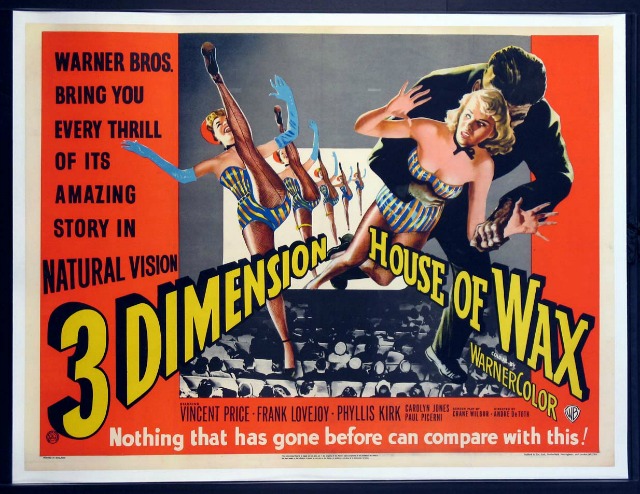Comin' At Ya! 3-D Delights At The Siskel Center
By Joel Wicklund in Arts & Entertainment on Jan 8, 2015 7:00PM

Original promo art for "House of Wax" (© Warner Bros.).
Things are really popping at the Gene Siskel Film Center in early 2015. In fact, things will be popping out, or at least appearing to do so, as the venue presents a variety of 3-D showings throughout January and early February. In addition to the Chicago premiere of Jean-Luc Godard's eagerly awaited Goodbye to Language 3-D, the Film Center will put the focus squarely on the evolution of stereoscopic film with Dial 3 for 3-D (Jan. 17 - Feb. 5).
While there have been entire festivals devoted to 3-D filmmaking, this shorter series of five features manages to cover many of the most significant changes in the format, as well as varying artistic approaches — from the pure gimmickry of House of Wax to the immersive documentary work of Cave of Forgotten Dreams.
House of Wax (1953) was one of the first big 3-D hits, and it's a great deal of fun (the paddle ball guy is a hoot), but its 3-D pioneering is arguably less significant than the fact that it really established Vincent Price as a horror icon. Prior to then (an early starring role in The Invisible Man Returns notwithstanding), Price had appeared in a wide range of non-horror genres, mostly in supporting roles. He wouldn't fully embrace his sinister image until the late '50s, but the massive box office success of House of Wax permanently made him a big-screen boogeyman in the collective mind of the public.
I've never seen the original Creature from the Black Lagoon (1954) in 3-D, though as a kid I was one of hundreds of thousands desperately working the "rabbit ears" antennae to try to improve the effect during the infamous Son of Svengoolie telecast of its sequel, Revenge of the Creature. Regardless of the impact of the 3-D, the first entry in the "Gill Man" series is a must-see and the title creature was the last of the classic Universal monsters.
Arguably the first Hollywood feature to use 3-D in an aesthetically thoughtful way, Alfred Hitchcock's Dial M for Murder (1954) was actually barely seen in the format during its original release. The market had been flooded with 3-D films over the previous year and the public was already growing tired of the novelty (countless projection problems didn't help), so aside from a handful of early screenings, the public only saw a standard 2-D version. A re-release in the '80s allowed more viewers to see it in 3-D, but a later conversion to a single strip process (the original was a 2-strip 3-D release) brought complaints about the quality. The DCP version showing at the Film Center reportedly captures the effect as Hitchcock intended.
The only one of the five films in the series I have not seen at all, The Bubble (1966), established a single-strip, widescreen 3-D process marketed as "Space-Vision." The Bubble was written and directed by Arch Oboler, one of the greats from the era of classic radio drama. Oboler's work for the horror-suspense program Lights Out is legendary, and a great place to introduce anyone to the joys of "old time radio." He was less successful in film (though his survivalist sci-fi film Five is worth a look), but his place in movie history was secured with an earlier 3-D film, Bwana Devil. That movie, which promised "A lion in your lap...a lover in your arms," was the first true 3-D hit, paving the way for House of Wax and everything that followed.
I'm a great admirer of Werner Herzog, but Cave of Forgotten Dreams (2010) is a rare work from the German master filmmaker to leave me a little bit cold. Still, this up-close look at prehistoric cave paintings that are among the oldest known examples of human pictorial art is certainly worth revisiting. The 3-D camerawork does make you feel like you are deep in the cave, exploring these ancient creations.
If these films or Goodbye to Language have not satisfied your 3-D appetite, the Film Center also will be showing the work of another German auteur experimenting with the format. Wim Wenders' Pina (2011) puts the effect to use in showcasing the choreography of Pina Bausch. It is showing Feb. 1- 4.
Dates and show times for all films are available at the Gene Siskel Film Center's website.